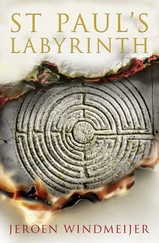“I can’t possibly jump between those beams,” Sienna whispered.
Langdon doubted he could either, and falling would be certain death. He aimed the flashlight down through the open space between the struts.
Eight feet below them, suspended by iron rods, hung a dusty horizontal expanse — a floor of sorts — which extended as far as they could see. Despite its appearance of solidity, Langdon knew the floor consisted primarily of stretched fabric covered in dust. This was the “back side” of the Hall of the Five Hundred’s suspended ceiling — a sprawling expanse of wooden lacunars that framed thirty-nine Vasari canvases, all mounted horizontally in a kind of patchwork-quilt configuration.
Sienna pointed down to the dusty expanse beneath them. “Can we climb down there and walk across?”
Not unless you want to fall through a Vasari canvas into the Hall of the Five Hundred.
“Actually, there’s a better way,” Langdon said calmly, not wanting to frighten her. He began moving down the strut toward the central backbone of the garret.
On his previous visit, in addition to peering through the viewing window in the room of architectural models, Langdon had explored the garret on foot, entering through a doorway at the other end of the attic. If his wine-impaired memory served him, a sturdy boardwalk ran along the central spine of the garret, providing tourists access to a large viewing deck in the center of the space.
However, when Langdon arrived at the center of the strut, he found a boardwalk that in no way resembled the one he recalled from his tour.
How much Nebbiolo did I drink that day?
Rather than a sturdy, tourist-worthy structure, he was looking at a hodgepodge of loose planks that had been laid perpendicularly across the beams to create a rudimentary catwalk — more of a tightrope than a bridge.
Apparently, the sturdy tourist walkway that originated at the other end extended only as far as the central viewing platform. From there, the tourists evidently retraced their steps. This jerry-rigged balance beam that Langdon and Sienna now faced was most likely installed so engineers could service the remaining attic space at this end.
“Looks like we’re walking the plank,” Langdon said, eyeing the narrow boards with uncertainty.
Sienna shrugged, unfazed. “No worse than Venice in flood season.”
Langdon realized she had a point. On his most recent research trip to Venice, St. Mark’s Square had been under a foot of water, and he had walked from the Hotel Danieli to the basilica on wooden planks propped between cinder blocks and inverted buckets. Of course, the prospect of possibly getting one’s loafers wet was a far cry from that of plunging through a Renaissance masterpiece to one’s death.
Pushing the thought from his mind, Langdon stepped out onto the narrow board with a feigned self-assurance that he hoped would calm any worries Sienna might secretly be harboring. Nonetheless, despite his confident exterior, his heart was pounding as he moved across the first plank. As he neared the middle, the plank bowed beneath his weight, creaking ominously. He pressed on, faster now, finally reaching the other side and the relative safety of the second strut.
Exhaling, Langdon turned to shine the light for Sienna and also offer any coaxing words she might need. She apparently needed none. As soon as his beam illuminated the plank, she was skimming along its length with remarkable dexterity. The board barely bent beneath her slender body, and within seconds she had joined him on the other side.
Encouraged, Langdon turned back and headed out across the next plank. Sienna waited until he had crossed and could turn around and shine the light for her, and then she followed, staying right with him. Settling into a steady rhythm, they pressed on — two figures moving one after the other by the light of a single flashlight. From somewhere beneath them, the sound of police walkie-talkies crackled up through the thin ceiling. Langdon permitted himself a faint smile. We’re hovering above the Hall of the Five Hundred, weightless and invisible.
“So, Robert,” Sienna whispered. “You said Ignazio told you where to find the mask?”
“He did … but in a kind of code.” Langdon quickly explained that Ignazio had apparently not wanted to blurt out the mask’s location on the answering machine, and so he had shared the information in a more cryptic manner. “He referenced paradise, which I assume is an allusion to the final section of The Divine Comedy . His exact words were ‘Paradise Twenty-five.’ ”
Sienna glanced up. “He must mean Canto Twenty-five.”
“I agree,” Langdon said. A canto was the rough equivalent of a chapter, the word harkening back to the oral tradition of “singing” epic poems. The Divine Comedy contained precisely one hundred cantos in all, divided into three sections.
Inferno 1–34
Purgatorio 1–33
Paradiso 1–33
Paradise Twenty-five , Langdon thought, wishing his eidetic memory were strong enough to recall the entire text. Not even close — we need to find a copy of the text.
“There’s more,” Langdon continued. “The last thing Ignazio said to me was: ‘The gates are open to you, but you must hurry.’ ” He paused, glancing back at Sienna. “Canto Twenty-five probably makes reference to a specific location here in Florence. Apparently, someplace with gates.”
Sienna frowned. “But this city probably has dozens of gates.”
“Yes, which is why we need to read Canto Twenty-five of Paradise .” He gave her a hopeful smile. “You don’t, by any chance, know the entire Divine Comedy by heart, do you?”
She gave him a dumb look. “Fourteen thousand lines of archaic Italian that I read as a kid?” She shook her head. “You’re the one with the freakish memory, Professor. I’m just a doctor.”
As they pressed on, Langdon found it sad somehow that Sienna, even after all they’d been through together, apparently still preferred to withhold the truth about her exceptional intellect. She’s just a doctor? Langdon had to chuckle. Most humble doctor on earth , he thought, recalling the clippings he’d read about her special skills — skills that, unfortunately but not surprisingly, did not include total recall of one of history’s longest epic poems.
In silence, they continued on, crossing several more beams. Finally, up ahead Langdon saw a heartening shape in the darkness. The viewing platform! The precarious planking on which they were walking led directly to a much sturdier structure with guardrails. If they climbed onto the platform, they could continue on along the walkway until they exited the garret through a doorway, which, as Langdon recalled, was very close to the Duke of Athens Stairway.
As they neared the platform, Langdon glanced down at the ceiling suspended eight feet below. So far all the lunettes beneath them had been similar. The upcoming lunette, however, was massive — far larger than the others.
The Apotheosis of Cosimo I , Langdon mused.
This vast, circular lunette was Vasari’s most precious painting — the central lunette in the entire Hall of the Five Hundred. Langdon often showed slides of this work to his students, pointing out its similarities to The Apotheosis of Washington in the U.S. Capitol — a humble reminder that fledgling America had adopted far more from Italy than merely the concept of a republic.
Today, however, Langdon was more interested in hurrying past the Apotheosis than in studying it. As he hastened his pace, he turned his head ever so slightly to whisper back to Sienna that they were nearly there.
Читать дальше
Конец ознакомительного отрывка
Купить книгу










